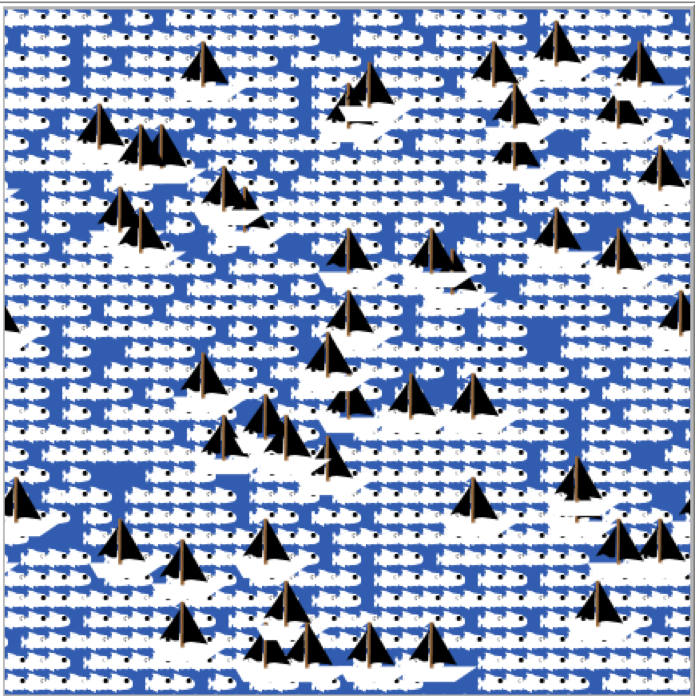Overfishing problem
Contents
Introduction
Fish population is declining around the world due to excessive fishing and ignoring the limiting measures. The catch of may commercial fish species in the North Sea has decreased over the past decades. The most important measure is the total allowable catch, used by all the countries that can fish in the North Sea. We can use data from ICES (International Council for the Exploration of the Sea). The TAC gives for every sort of fish the total number of fish that can be captured by all the European countries together in an fishing area. The intention is to create a simulation of a fishing area and based on historic catches of a specific sort of fish, determine how much of this fish there can be captured every year before it becomes extinct. There are different factors that influence this : the number of fishing ships in the fishing area, the total number of this fish in the area, the procreation of this fish every year and the amount of fish every ship can capture every year depending on his capacity. First this is explained by a simulation where all these factors are known, and then is this model applied on the real data of the North Sea. We want to define when a fishing sort will soon become extinct.
In an investigation conducted by the Government of the Netherlands, based on the data from ICES in 2017, the number of the fish sort herring decreased since 1950 from 5000 million kg till 2000 million kg, a decrease of 60% in 65 years. This wasn’t a linear decline. Policy measures were forced to make sure that herring didn’t became extinct. The countries of the European Union have to follow these measures if they want that the population of herring won’t become in the danger zone. The goal of the simulation will be to model the long-term effects of declining herring population in case of ignoring the TAC measures and in case of accepting the TAC measures.
Method
Software
NetLogo 6.0.2 (2D) was the most appropriate software to illustrate this model.
Simulation details
The simulation is tailored to a study [1] by the Government of the Netherlands on 3 October 2017. It analysed the herring population in the North Sea from 1947 till 2017 and the catching fish in the North-Sea from 2002 till 2017. We created a fictive fishing area in the North Sea. We describe 2 models. First we start by ignoring the rules introduced by the government. We have an initial number of ships we can choose in the area, and each ship has a capacity to capture fish which can also vary. The number of herring is expressed in millions of kg. The number of fish in the area can be chosen. The ships and fish move random in the area and can’t leave. In this simulation, fish can only die when they are captured by a ship, they don’t survive by eating and can’t die another way, we didn’t introduce this because this was irrelevant to our model. The amount a ship can kill is depending on it’s capacity. A ship is full when his remaining capacity is zero.
The second version of the model shows us why it’s important that the TAC rules are implemented and why every country have to follow them in case we don’t want herring to become extinct. We introduce the TAC percentage, which we can choose. It describes the maximum percentage of fish we may capture in total and what happens to the population of fish if we accept this and don’t break these rules.
Model
Fish
Represented as white fish. The agent is commanded to randomly move around in the simulation and reproduce at a certain level. They only die in case of capturing by a ship, it only happens once and that’s when the fish and ship are on the same position. They are expressed in millions of kg.
Ships
Represented as 2-sailed boats. Each ship kills according to the real data 12 million fish each tick and we consider a tick as one year, so each month 1 million, because most fishing ships have a capacity of 1 million kg storing space.
Visualization of the problem
Settings
In the model version, we can choose between ignoring the TAC rules and accepting the TAC rules. When we ignore them, we focus on the fact in which time and by which number of ships and their capacity herring will become extinct.
Adjusting the initial-number-ships slider shows us how drastically the number of ships can change the slope on the population plot.
Adjusting the initial-capacity slider also shows us how drastically the amount of capacity can change the slope. We introduced this slider because there are a lot of different capacities in reality, in that way we can use the software on different models.
Adjusting the fish-reproduce slider let us change the birth rate. A reproduction rate of 100% allows 1 kg of fish to create one kg of offspring. We calculated the birth rate by the data we got from the weight of a herring and the number of children. To yield best results the production rate should be set to 70%. We assume that half of the population is female and has more then one offspring, minus habitat loss.
The initial-number-fish slider controls how many fish you want to participate in the model. Herring population varies by region, also in varies by region in the North Sea.
The TAC slider is the percentage of the total allowable catch, so the maximum of fish that can be captured when we want to prevent the herring of extinction. This percentage of the number of fish remaining in the area is the maximum we can catch, specified by ICES.

